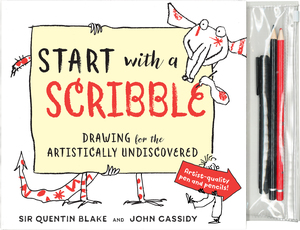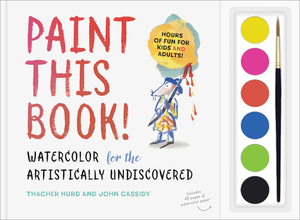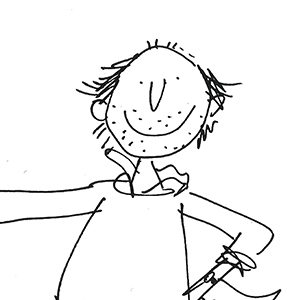 Enlarge Cover
Media/Desk Copy Request
Enlarge Cover
Media/Desk Copy Request
This utterly encouraging book is a masterclass in how to draw for kids and grownups with Sir Quentin Blake, beloved illustrator to Roald Dahl.
Can you find the pointy end of a pencil? Then you can draw! Start with a Scribble will banish your inner critic and kick-start your inner genius, as you learn to capture the spirit of things with a little how-to and a lot of just-do. An artist-quality pen and two watercolor pencils (red and black) are included. Inside, you’ll find:
- Prompts to inspire you (e.g., “emotional rabbits”)
- Doodles to finish (“Mrs. Thudkins takes her floppaterasis for a walk”)
- Techniques to try (only when the mood strikes you), from shading to perspective
- And plenty of wide-open space to play around in.
Sir Quentin’s sage advice appears throughout, from “it’s best to name your animal after you draw it” to “don’t worry too much yet about ankles.” The most important lesson? YOU are the only person qualified to express your unique you-ness.
Publisher’s note: Start with a Scribble is an updated North American edition of Drawing for the Artistically Undiscovered (Klutz, 1999).
★ Parents’ Choice Gold Award Winner (1999)
National Parenting Publications Gold Award Winner (1999)
“Belongs in every elementary classroom library and home. Its fun-filled humorous illustrations will not only stimulate readers’ imaginations but tap into their creative processes.”—New York Journal of Books
“What a marvelous book—funny, accessible and inspirational. . . . The ‘artistically undiscovered’ will thrill to hear the author’s advocation of the Gung-Ho approach, his urge to express your ‘you-ness’ and capture the spirit of things on paper. From drawing spectacles and emotional rabbits to creating a 3-Headed Red-Spotted Gorff (whatever that is) and dealing with human anatomy, Blake’s quirky guide will have you scribbling away in glee.”—Kirkus UK
“There are lots of tricks artists know, and they’re not hard to learn. You just need the right instructor . . . [Paint This Book! and Start with a Scribble] fit the bill perfectly . . . both are filled with fun, light illustrations . . . and although these books leave plenty of room for artistic imagination, for me their real value is the way they introduce the ideas of perspective, line quality, and other helpful tools for beginning artists.”—Kathy Ceceri, WIRED.com





